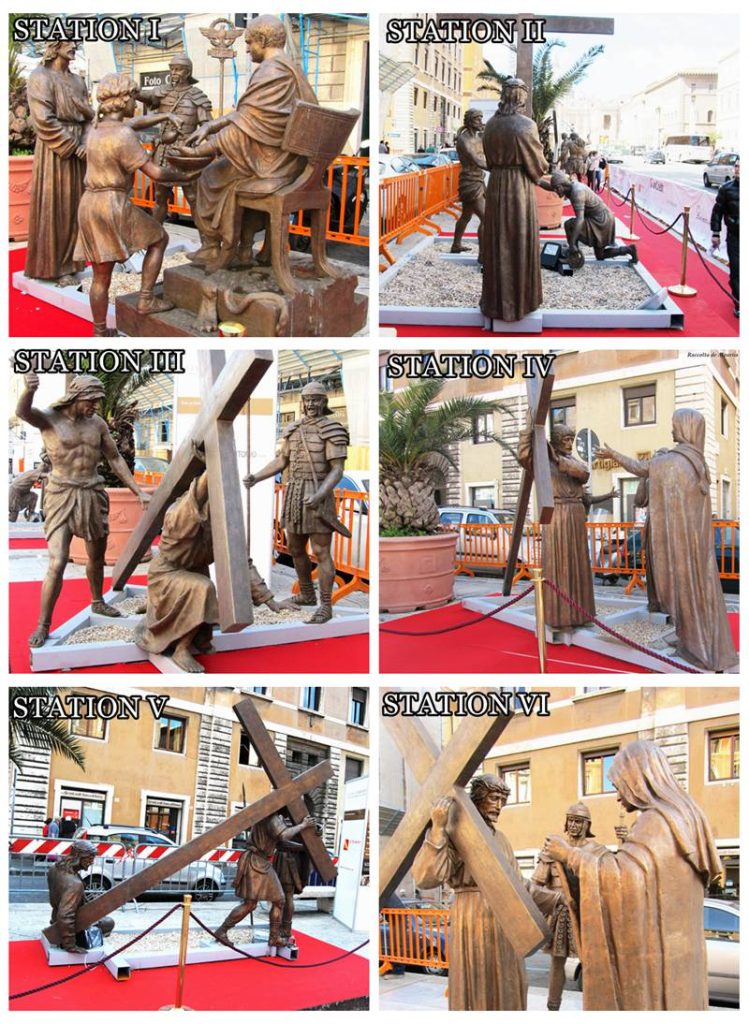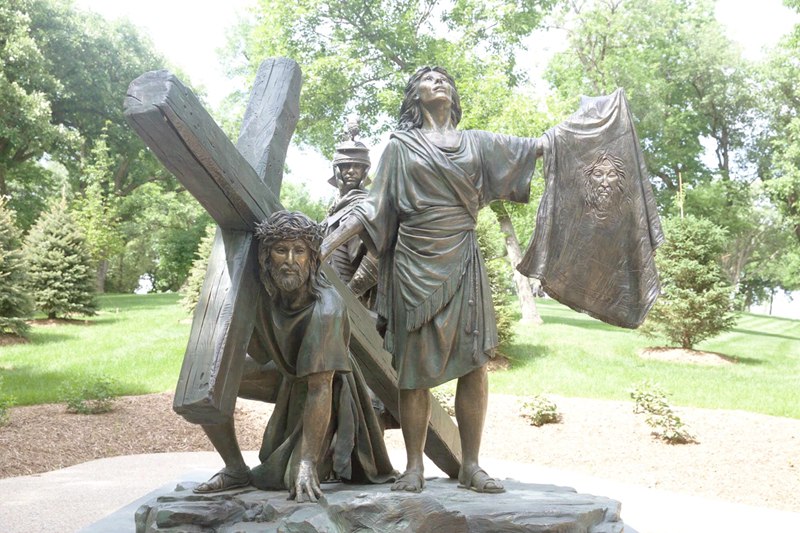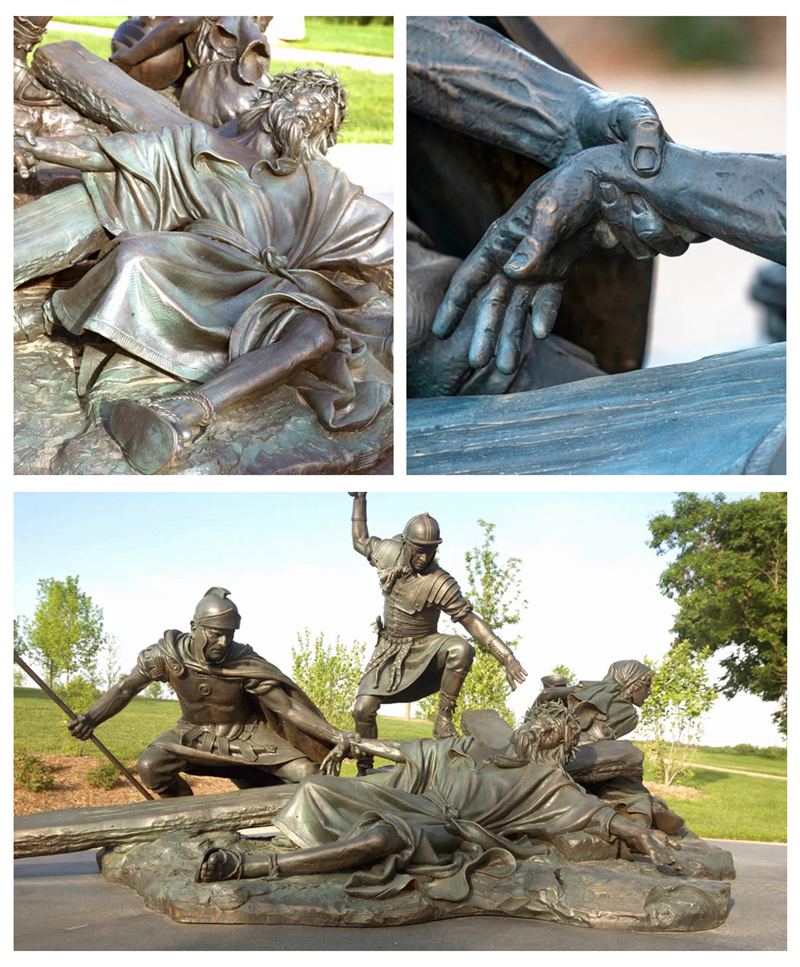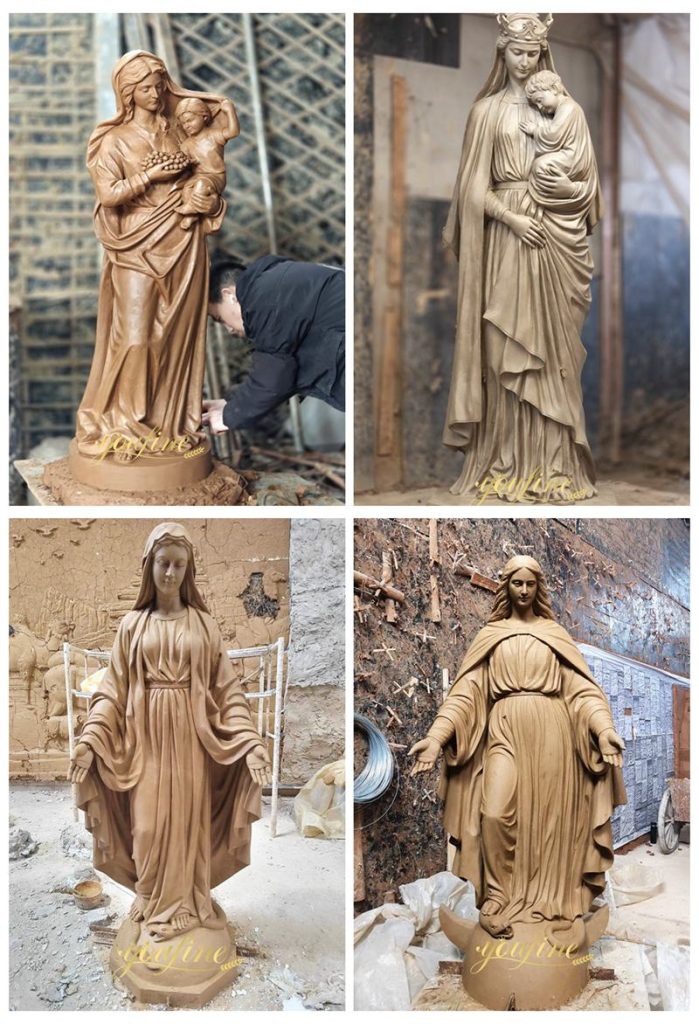Today let us introduce the specific details of the 14 stations through bronze sculptures. Furthermore, depending on the artist’s interpretation of the Stations of the Cross, the shapes of these sculptures and the scenes they depict are slightly different.

How Many Stations of the Cross?
14 stations
Stations of the Cross, also known as the Way of the Cross or Via Crucis. In many monasteries and religious places, people would cast bronze stations of the cross to commemorate the suffering and death of Jesus on the cross. There are 14 stations, each depicting each significant moment of his journey to Calvary. Modern man prays and reflects as he passes through this sacred path.

what are the Stations of the Cross?
The Stations of the Cross or Way of the Cross, also known as the Way of Sorrows or Way of the Cross, are a series of scenes depicting the Passion of Jesus Jesus and accompanying prayers. In many cases, believers would cast bronze stations of the cross to visually depict the road. These stations were developed after the Stations of the Cross in Jerusalem.

This is a traditional procession route that symbolizes Jesus’ path to Calvary. The purpose of these sites is to help believers gain insight for their own lives through contemplation of the Passion of Jesus. It has become one of the most popular prayers. Stations could be found in many Western churches.

14 Station of the Cross with Description
STATION I Jesus is condemned to death
In this bronze station of the cross sculpture, Pontius Pilate hands Jesus over to His adversaries, condemning Him to death. The artwork vividly portrays the moment of Jesus’s betrayal and condemnation. The solemn expression on Jesus’ face conveys the weight of His sacrifice and the injustice of His fate.

This bronze station of the cross sculpture captures the pivotal moment in the Passion of Jesus, depicting the profound themes of suffering, redemption, and the human experience of injustice and divine purpose.

STATION II Jesus is Made to Bear His Cross
In this depiction, Jesus lovingly embraces His cross, tenderly kissing it before shouldering the weight of His burden. The bronze sculpture captures the poignant moment as Jesus, with bruised shoulders and unwavering resolve, takes up the cross.

The artwork conveys both the physical and spiritual significance of this act, symbolizing Jesus’s acceptance of His redemptive mission and the path of suffering He willingly undertakes for humanity’s salvation. Through this powerful image, viewers are invited to contemplate the depth of Jesus’s sacrifice and His unwavering love and devotion to fulfill His divine purpose.

STATION III Jesus Falls the First Time
In this bronze sculpture, Jesus, weakened by the heavy weight of His cross and burdened by the weight of humanity’s sins, falls to the ground in exhaustion. The artwork captures the moment of Jesus’s first fall under the weight of His cross, symbolizing the physical and spiritual challenges He endured during His journey to Calvary. The stations of the cross sculpture conveys a profound sense of human frailty and divine strength, highlighting the sacrificial nature of Jesus’s mission and His willingness to bear the sins of the world.

STATION IV Jesus Meets His Mother
In this poignant bronze sculpture, Mary, the mother of Jesus, encounters her beloved Son as He is driven through the streets bearing the heavy burden of the Cross, escorted by savage executioners. The artwork captures the profound and sorrowful meeting between Mother and Son amidst the tumultuous scene of Jesus’s journey to Calvary.

The sculpture conveys the deep emotional and spiritual bond between Mary and Jesus, illustrating the anguish and anguish of a mother witnessing her son’s suffering and imminent sacrifice.

STATION V Simon of Cyrene Helps Bear the Cross
In this compelling bronze sculpture, Simon of Cyrene is depicted as being forced to assist Jesus in carrying His Cross along the agonizing path to Calvary. The scene captures the moment of unexpected compassion and involvement, as Simon is compelled to share in Jesus’s burden.

The sculpture symbolizes the universal call to bear one another’s burdens and the unexpected ways in which individuals are drawn into the redemptive journey of Christ.

STATION VI Veronica Wipes the Face of Jesus
In this bronze sculpture, Veronica steps forward and presents her veil to Jesus, offering to wipe the sweat and blood from His face as He endures the agonizing journey with the Cross. Moved by her compassion, Jesus accepts the gesture, and miraculously, His true image is imprinted on the cloth when He returns it to her. The bronze stations of the cross sculpture capture the profound act of compassion and the miraculous encounter between Veronica and Jesus during the Via Dolorosa.


STATION VII Jesus Falls a Second Time
In this poignant bronze sculpture, Jesus, overwhelmed by the weight of the Cross and weakened by His ordeal, falls to the ground for the second time. Despite His exhaustion, His cruel executioners relentlessly whip Him, urging Him to rise and continue His agonizing journey to Calvary. The bronze stations of the cross capture the intense physical and emotional suffering endured by Jesus during His Passion.

STATION VIII Jesus Speaks to the Women of Jerusalem
In this moving scene depicted in bronze sculpture, the devoted women of Jerusalem weep for Jesus as He walks along the Via Dolorosa. Jesus, filled with compassion even in His suffering, turns to the women and speaks to them: “Weep not for me, but weep for yourselves and for your children; for it is because of sins, both yours and theirs, that I endure this suffering.”

The bronze stations of the cross sculpture capture the profound exchange between Jesus and the women of Jerusalem, emphasizing the spiritual significance of His sacrifice and the call to repentance and renewal.

STATION IX Jesus Falls a Third Time
In this solemn bronze sculpture, Jesus, utterly exhausted and burdened by the weight of the Cross and the collective sins of humanity, falls to the ground for the third time along the Via Dolorosa. The weight of His physical and spiritual agony is palpable, symbolizing the profound suffering endured by Jesus in His redemptive journey.

The sculpture captures the intense and poignant moment of Jesus’ final fall, underscoring the crushing weight of sin and the immense sacrifice He willingly embraces for the salvation of humanity.

STATION X Jesus is Stripped of His Garments
In this evocative bronze sculpture depicting the scene at Calvary, Jesus is cruelly stripped of His garments, causing further anguish and pain as parts of His tortured flesh are torn away with them. The sculpture captures the brutal and dehumanizing act of stripping Jesus of His clothing, adding to His physical suffering and humiliation.

STATION XI Jesus is Nailed to the Cross
In this powerful bronze sculpture depicting the crucifixion, Jesus is violently thrown down, and His hands and feet are cruelly nailed to the cross. The scene captures the excruciating pain and suffering endured by Jesus as He offers Himself willingly for the salvation of humanity. The sculpture portrays Jesus’ patient and steadfast endurance of suffering, emphasizing His profound sacrifice for all.


STATION XII Jesus Dies on the Cross
In this profound bronze sculpture depicting the crucifixion, Jesus hangs on the cross, enduring excruciating suffering and abuse from the soldiers around Him. Despite the torment and agony, Jesus remains on the cross until His final breath, fulfilling His divine mission of redemption.

The sculpture captures the solemn and sacrificial moment of Jesus’s death on the cross, symbolizing the culmination of His earthly ministry and the ultimate expression of His love for humanity.

STATION XIII Jesus is Taken from the Cross
In this moving bronze sculpture, Jesus is tenderly taken down from the cross and placed into the arms of His beloved Mother, Mary. The scene captures the profound sorrow and grief of Mary as she receives her Son’s lifeless body, embodying the anguish of a mother who has witnessed the ultimate sacrifice.

The bronze stations of the cross sculpture symbolize the poignant moment of Jesus’s descent from the cross, emphasizing the human aspect of His suffering and the intimate bond between Jesus and Mary.

STATION XIV Jesus is Placed in the Sepulcher
In this poignant bronze sculpture, the lifeless body of Jesus is reverently placed in a stranger’s tomb, fulfilling the prophecy that He would have no grave of His own after death. The scene captures the solemn and somber moment as Jesus’s body is laid to rest, surrounded by the profound mystery of His sacrificial death. The bronze stations of the cross sculpture symbolize the culmination of Jesus’s earthly journey and the anticipation of His resurrection.


Undertaken many bronze religious sculpture projects:
Has an Exquisite Clay Model:
Every time we make a bronze religious sculpture, our artists make a clay model of the same proportions. And our artist is a devout Catholic who has the God-given ability to carve every detail and expression of Jesus. Moreover, he sincerely integrates his beliefs into every minute and every second of creating sculptures. Our artists have the strongest spiritual beliefs. They could definitely provide you with a set of extremely exquisite stations of the cross sculpture.


More Bronze Religious Sculptures on Display:
Our bronze Jesus sculptures come in different shapes and looks. Some customers want to cast Jesus on the cross, some want a sculpture of Jesus with the Sacred Heart, and then there are church customers who cast a sculpture of Jesus with open hands. So with our extensive experience in casting bronze religious sculptures, our stations of the cross sculpture are sure to please your parishioners.


If you are planning to cast a series of bronze stations of the cross sculpture for churches and monasteries please feel free to contact us. We accompany and serve our customers from the initial design of the project to the final installation. Believe in the absolute strength of YouFine, our bronze Jesus sculpture would definitely make everyone feel the absolute power of faith.
Good Morning,
Could you please send us a quote of the 14 stations? Our church has a space that we would like to convert into the stations of the cross permanently and I think your statues would look great there.
Good morning,
Thank you for your inquiry! We are glad to know that you would like to transform the space of your church into a permanent Stations of the Cross and are interested in our sculptures.
We have a team of experienced artists and craftsmen who can create beautiful Stations of the Cross sculptures for you and provide professional services. We will prepare a detailed quotation and proposal for you as soon as possible.
Have a nice day!